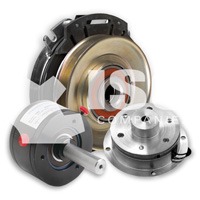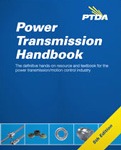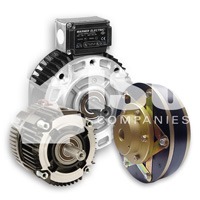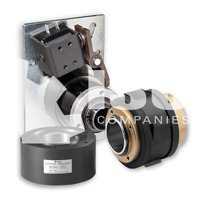 Magnetic / Electromagnetic Clutches & Brakes
Magnetic / Electromagnetic Clutches & Brakes
ISC Companies and affiliate Adams-ISC are distributors of mechanical power transmission parts including non-friction clutches and brakes. For more information about the brands we offer and/or pricing, please contact us by phone 763-559-0033, by email [email protected], or by filling out our online contact form.
These non-friction clutches and brakes use magnetic attraction to transfer torque from input to output. They are commonly used in applications that require variable slip or soft engagement. They are typically larger than friction types because they provide less torque for a given diameter. Eddy-current, hysteresis, and magnetic clutches and brakes are used in light- to medium-duty applications such as wire and film tensioning, labeling, and printing.
Electromagnetic (Electromechanical/EM) Clutch Characteristics
- Operate electrically, transmit torque mechanically
- Very high torque to size ratio
- Engagement time depends on magnetic strength, air gap, and inertia
- Random start/stop
- Power-on and power-off braking
- Soft start/stop
- Bi-directional rotation
Electromagnetic (Electromechanical/EM) Brake Types
- Power-On: Engage the brake when power is applied to the holding coil.
- Power-Off: Release the brake when power is applied. A spring holds the brake closed or engaged (no power) during operation. The brake will hold the load in a fixed position if power fails.
Electromagnetic Clutch
When the clutch is actuated, current flows through the electromagnet producing a magnetic field. The rotor portion of the clutch becomes magnetized and attracts the armature. The armature is pulled against the rotor and a frictional force is generated at contact. The load will then accelerate to match the speed of the rotor, thereby engaging the armature and the output hub of the clutch.
Power-On Electromagnetic Brake
The brake is positioned on the load shaft with the armature assembly secured to the shaft and the field assembly is mounted to a non-rotating component or bulkhead. Before the coil energizes, the armature assembly rotates freely. When energized, the field assembly becomes an electromagnet, which attracts the armature plate and stops the load.
Power-Off Electromagnetic Spring-Set Brake
In normal power-off mode, springs apply pressure to the non-rotating armature plate, which applies pressure to the rotor. The rotor can float back and forth under the applied pressure, depending on the state of the coil. When the coil energizes, the brake spline decouples from the load shaft and the load rotates freely.
Power-Off, Permanent Magnet Brakes
A permanent magnet holding brake looks very similar to a standard electromagnetic brake, but instead of squeezing a friction disc, via springs, it uses permanent magnets to attract a single-face armature to create the braking action. When the coil energizes, the electromagnet forms an opposing magnetic force to the permanent magnet and lets the armature assembly rotate freely.
Types of EM Clutches and Brakes
Magnetic particle designs engage using electromagnetic force as an actuation medium. The space between the input and output units is filled with dry iron particles. When power is applied, magnetic flux lines span the space, and particles line up to form a bond between input and output units. They are ideal for tension control applications where speed is continually changing, such as wire winding, foil, film, and tape tension control. Because of their fast response, they are suitable for high-cycle applications, such as card readers, sorting machines, and labeling equipment .
An eddy current clutch input rotor is magnetized when the coil is energized with DC current. The magnetic flux of the input rotor then causes small eddy currents to flow in the non-ferrous output rotor. These eddy currents create their own magnetic flux that reacts with the input rotor to transmit torque.
Eddy current brakes have a fixed output unit and a rotating brake rotor. If the brake rotor is spinning when the field coil is energized, eddy currents created in the brake rotor produce a magnetic field that opposes the rotation. Examples: train and roller coaster brakes.
Hysteresis clutches are like eddy current clutches except the output rotor of the clutch is made of ferrous material. When a current is applied to the actuator coil, the input rotor is magnetized. The magnetic field causes the output rotor to magnetize, rotating the output rotor through the interaction fields.
In a hysteresis brake, the input field assembly is held stationary causing the output rotor to come to a stop to line up with the stationary field assembly when the actuator coil is energized. Hysteresis brakes excel in fractional horsepower applications that require precise control. Examples: food packaging, capping, bolting, and screwing.
High strength magnets allow for the manufacture of permanent magnet clutches and brakes that require little to no input power to operate. These designs offer consistent torque levels regardless of speed. Internal magnets are user-adjusted to provide torque for the application. Examples: robotics, holding brakes for Z-axis ball screws, servo motors.
Top Brands We Offer
 Content on this page was created using excerpts from the Power Transmission Handbook (5th Edition), which is written and sold by the Power Transmission Distributor’s Association (PTDA).
Content on this page was created using excerpts from the Power Transmission Handbook (5th Edition), which is written and sold by the Power Transmission Distributor’s Association (PTDA).








You must be logged in to post a comment.